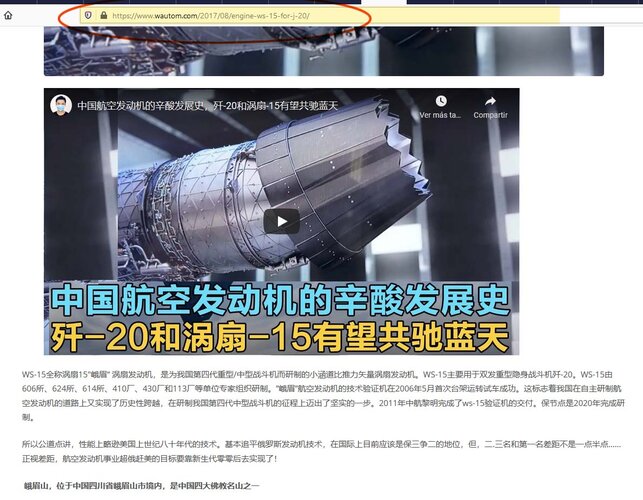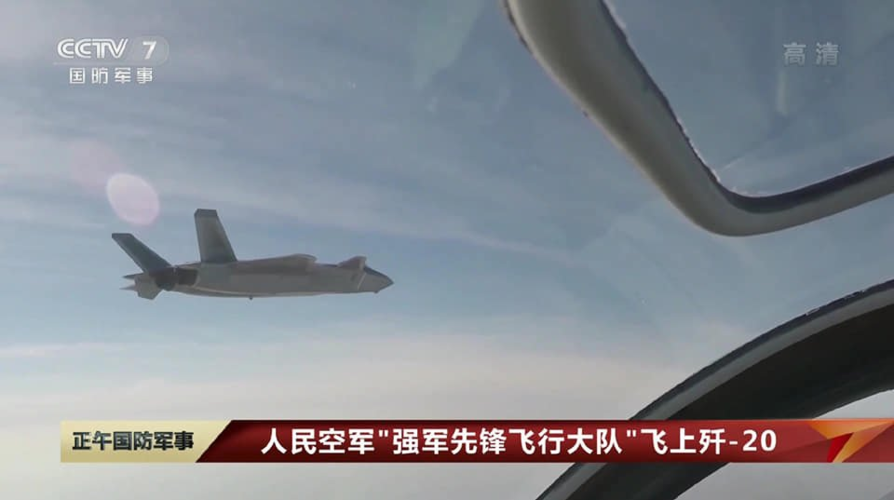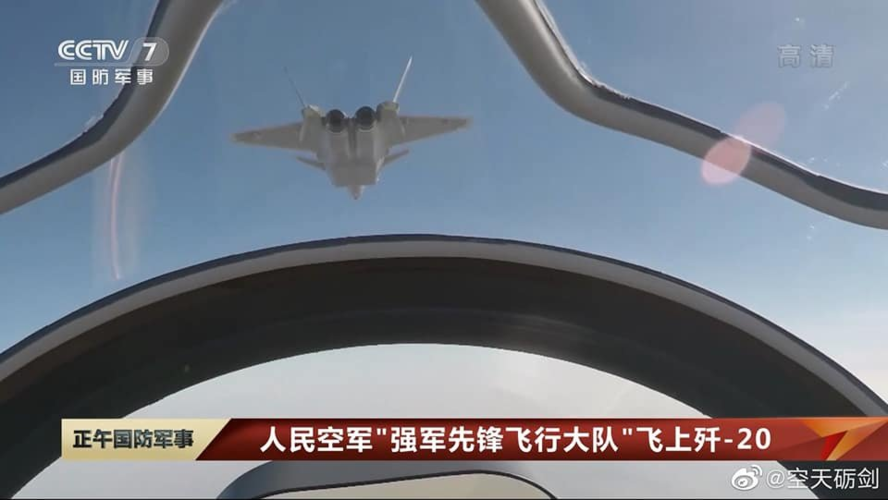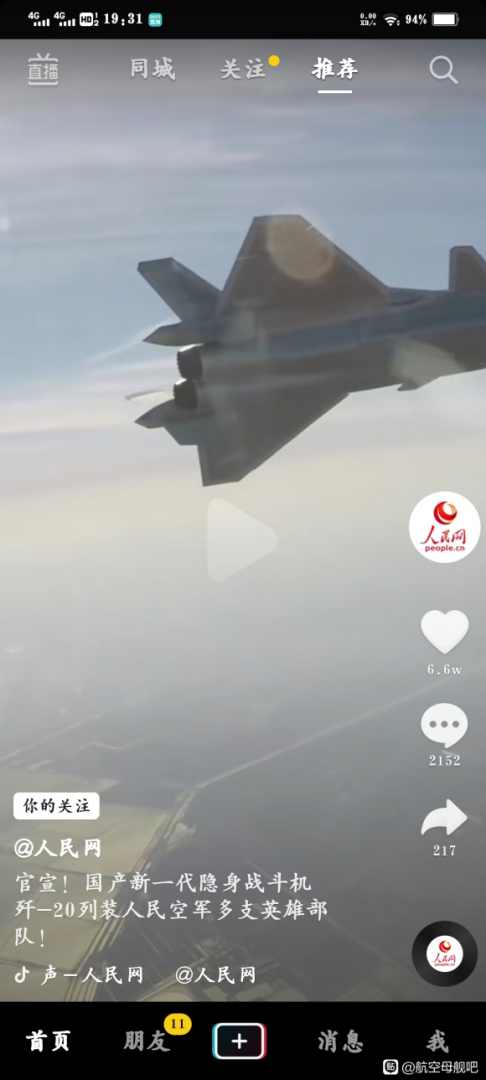FighterJock
ACCESS: Above Top Secret
- Joined
- 29 October 2007
- Messages
- 5,609
- Reaction score
- 5,939
The text even mentions that there may be a cannon but no obvious site, here we go again.
The picture discussed in above link:

Notice also the different shape of the sensor on the inlet lip (below the twin bypass outlets)
Nothing official, estimates range from 1250 km (slightly higher than F-35C) to 2000 km combat radius. There's a claim somewhere of a tanked range of 5500 km. Compare over 3000 km F-22 ferry range, 4500 km Su-57 ferry range with external tanks.Is there any public range figure for the single seat version?
Eeeeeegh... That's optimistic)WS-10C is apparently in the same range as the Su-57's engines
Erm, should have specified AL-41 / 117S, not Izdeliye 30. Should be in the 137-142kN range. Note that the intended WS-15 engine is supposed to be in the 17-18 ton range, and that the Chinese really screwed up by developing AL-31 / F110-class engines, instead of F404-type engines, where the smaller engine would have presented lesser technical challenges and allowed the Chinese to compensate for technological inferiority by simply using more, but smaller engines.Eeeeeegh... That's optimistic)WS-10C is apparently in the same range as the Su-57's engines
The Su-57 has a 117M engine with 15 tons of thrust.Erm, should have specified AL-41 / 117S,
Just use Breguet range equation to do some calculations for range estimates. Feed in some feasible L/D, SFC or fuel fraction (e.g. compare with other aircraft published data) then see what you get out.
Double digit L/D at Mach 1.2 seems optimistic... as does OEW of 17t.
Also need to consider the SFC values you're using. SFC at SLS uninstalled is very different from what you'll actually get at cruise conditions. The value you're currently using is more representative of a modern civil high bypass ratio turbofan

No such thing as 117M. Only 117 and 117S. As for WS-10 - they themselves say it's a match to AL-31, not 41.The Su-57 has a 117M engine with 15 tons of thrust.
WS-10C is analogous to Izdeliye 117, WS-15 to Izdeliye 30.No such thing as 117M. Only 117 and 117S. As for WS-10 - they themselves say it's a match to AL-31, not 41.The Su-57 has a 117M engine with 15 tons of thrust.
May be. But from what I see we don't know enough about either WS-15 or Izd. 30 to make such claims.WS-10C is analogous to Izdeliye 117, WS-15 to Izdeliye 30.
WS-10C is a developed WS-10. WS-15 is a new design.May be. But from what I see we don't know enough about either WS-15 or Izd. 30 to make such claims.WS-10C is analogous to Izdeliye 117, WS-15 to Izdeliye 30.
Just use Breguet range equation to do some calculations for range estimates. Feed in some feasible L/D, SFC or fuel fraction (e.g. compare with other aircraft published data) then see what you get out.
Well it's actually bit more complex than that.. Used as it is. The breguet range would give "ferry range" which is... the "1 way" range. More iterations are needed. Like fuel utilizations, calculations of SFC during combat and returning to base, the aircraft's L/D's.
But anyway did that in excel with following assumptions :
Empty weight : 17000 Kg
Fuel weight of : 11000 Kg
L/Dmax of : 11 (looks reasonable, as far as i see typical fighters are about 10-13)
Cruise L/D is assumed to be 93.4% of the L/D max
Payload of 4000 Kg (weapons, pilot, etc)
Mission altitude of 12000-15000 m
Also Fuel utilizations need to be defined too. The radius or combat range is then effectively the cruise fuel.
The plane will "supercruise" throughout the mission at Mach 1.2. and doing afterburner during the combat as it would need some maneuvers. Then RTB, the fraction for RTB can be less than cruise phase one as the plane would drop payload. so it's lighter.
So what i got was that the combat range for my hypothetical J-20 there is 1384 Km. With enough fuel for 10 minutes of combat or dogfight with afterburner, and enough fuel for RTB with 6 minutes allowance for loiter awaiting landing.
Ah, in that sense I agree.WS-10C is a developed WS-10. WS-15 is a new design.
Izd. 117 is a developed AL-31F. Izdeliye 30 is a new design.
Analogous doesn't mean comparable.

I was unaware of any evidence of thrust vectoring in future versions. Where did that particular tidbit come from?Collecting all the possible information in dozens of forums and at the risk of some initial imprecision, I include this cutaway that anticipates the Chengdu J-20 version B, when it incorporates the new Chinese WS-15 engine since one of its problems is the lack of super cruise and its new BVR PL-15 missiles, 4 in the central interior warehouse, (the F-22 can already carry 6 new AIM-120s, and with the future AIM-260 Peregine this capacity will be much greater) I am also surprised that this bird still need parachute braking on landing, which lengthens work on the ground.
Regards MC72
PD: The infographic is currently in Spanish

I was unaware of any evidence of thrust vectoring in future versions. Where did that particular tidbit come from?
 (Traduction from Mandarin) https://www.wautom.com/2017/08/engine-ws-15-for-j-20/
(Traduction from Mandarin) https://www.wautom.com/2017/08/engine-ws-15-for-j-20/Same for the refueling pod and side inlets MADL
Just use Breguet range equation to do some calculations for range estimates. Feed in some feasible L/D, SFC or fuel fraction (e.g. compare with other aircraft published data) then see what you get out.
Well it's actually bit more complex than that.. Used as it is. The breguet range would give "ferry range" which is... the "1 way" range. More iterations are needed. Like fuel utilizations, calculations of SFC during combat and returning to base, the aircraft's L/D's.
But anyway did that in excel with following assumptions :
Empty weight : 17000 Kg
Fuel weight of : 11000 Kg
L/Dmax of : 11 (looks reasonable, as far as i see typical fighters are about 10-13)
Cruise L/D is assumed to be 93.4% of the L/D max
Payload of 4000 Kg (weapons, pilot, etc)
Mission altitude of 12000-15000 m
Also Fuel utilizations need to be defined too. The radius or combat range is then effectively the cruise fuel.
The plane will "supercruise" throughout the mission at Mach 1.2. and doing afterburner during the combat as it would need some maneuvers. Then RTB, the fraction for RTB can be less than cruise phase one as the plane would drop payload. so it's lighter.
So what i got was that the combat range for my hypothetical J-20 there is 1384 Km. With enough fuel for 10 minutes of combat or dogfight with afterburner, and enough fuel for RTB with 6 minutes allowance for loiter awaiting landing.
Why would someone use a stealthy fighter plane with a round refueling pod hanging below?While WS-15 on J20 may very well feature TVC, I somehow don't really trust a random blog on Chinese cars (and other topics)...
The video itself may very well be of WS-15 but it doesn't really give out any info as to just what is it really showing. Anyone could take such a video and title it "WS-15".
Same for the refueling pod and side inlets MADL
Refueling probe is pretty well documented by various older imagery.
MADL on the inlet however I am not sure about. Are you referring to the light gray protrusion below the hexagons? Is there any other probable use for such a protrusion? I guess RWR sensors would be within various leading and trailing edges on wings and rear parts of the plane...
It doesnt actually matter. I just pick some number which looks good. and run it. I wonder tho why not many more people use the breguet range equation, considering how widely it is the availability of the related materials.Just use Breguet range equation to do some calculations for range estimates. Feed in some feasible L/D, SFC or fuel fraction (e.g. compare with other aircraft published data) then see what you get out.
Well it's actually bit more complex than that.. Used as it is. The breguet range would give "ferry range" which is... the "1 way" range. More iterations are needed. Like fuel utilizations, calculations of SFC during combat and returning to base, the aircraft's L/D's.
But anyway did that in excel with following assumptions :
Empty weight : 17000 Kg
Fuel weight of : 11000 Kg
L/Dmax of : 11 (looks reasonable, as far as i see typical fighters are about 10-13)
Cruise L/D is assumed to be 93.4% of the L/D max
Payload of 4000 Kg (weapons, pilot, etc)
Mission altitude of 12000-15000 m
Also Fuel utilizations need to be defined too. The radius or combat range is then effectively the cruise fuel.
The plane will "supercruise" throughout the mission at Mach 1.2. and doing afterburner during the combat as it would need some maneuvers. Then RTB, the fraction for RTB can be less than cruise phase one as the plane would drop payload. so it's lighter.
So what i got was that the combat range for my hypothetical J-20 there is 1384 Km. With enough fuel for 10 minutes of combat or dogfight with afterburner, and enough fuel for RTB with 6 minutes allowance for loiter awaiting landing.
How reliable are the empty weight(s) for the J-20 and Su-57? They seem awfully light given the Raptor is around ~19,650kg. I grant that they are newer designs and may benefit from more recent manufacturing and material technologies but both are larger than the Raptor is. I wonder if there's some confusion about the OEW and the weight of the airframe without engines for example. I recall the F-22 started out with a airframe goal of 13,750kg minus the engines. The F119s supposedly weigh in at 1,800kg each so this translates to a estimated OEW of 17,350kg. It gained about 2,300kg during EMD apparently. Anyway don't mean sidetrack the discussion just wondering how realistic the empty weight assumptions are.



That's kind of large window for a small sensor ?
I wonder if it would fit bigger optics in the future.
Does the aperture moveable ?That's kind of large window for a small sensor ?
I wonder if it would fit bigger optics in the future.
The sensor must be as small as possible, the field of view as large as possible. That's what this is about.
